Elevate the experience of using talk within your workshop with some tools. ![]()
Viewing: Blog Posts Tagged with: partnerships, Most Recent at Top [Help]
Results 1 - 25 of 163
Blog: TWO WRITING TEACHERS (Login to Add to MyJacketFlap)
JacketFlap tags: writing workshop, partnerships, Talking, Add a tag
Blog: The Open Book (Login to Add to MyJacketFlap)
JacketFlap tags: Book News, first book, partnerships, Educator Resources, NEA Foundation, Tu Books, New Visions Award, New Voices/New Visions Award, Diversity, Race, and Representation, Add a tag
WASHINGTON – The National Education Association (NEA) Foundation and publisher Lee & Low Books have joined forces with First Book, a nonprofit social enterprise, to expand the Stories for All ProjectTM, First Book’s groundbreaking initiative to increase the diversity in children’s books. The new two-year collaboration, supported with funding from the NEA Foundation, includes the publication of a brand new book by a never-before-published author of color, and the production of thousands of diverse books, companion tipsheets and funds available for educators working with children from low-income families.
The diverse books include eight titles from Lee & Low Books, the largest U.S. multicultural children’s book publisher, and feature first-time authors of color, award winners, or books that previously were only available in hardcover formats. The titles will be printed as more affordable special edition paperbacks and available on the First Book Marketplace, First Book’s award-winning site offering  brand new books and educational resources – at the lowest possible prices or for free – to schools and programs serving children in need. A free, downloadable tipsheet will be developed for each title, with guidelines on how educators can use the book to create opportunities for student learning and shared experiences that embrace the importance of diversity and foster understanding both in and out of the classroom setting.
brand new books and educational resources – at the lowest possible prices or for free – to schools and programs serving children in need. A free, downloadable tipsheet will be developed for each title, with guidelines on how educators can use the book to create opportunities for student learning and shared experiences that embrace the importance of diversity and foster understanding both in and out of the classroom setting.
In addition, more than $100,000 from the NEA Foundation will be used to provide educators with credits to purchase diverse books through the First Book Marketplace. Many schools and programs have little or no budgets for books or resources for their programs; 74 percent of educators served by First Book spend their own money on educational resources for their students; national surveys indicate that teachers spend an average of $500 or more annually out of their own pocket.
LEE & LOW’s New Visions Award Expands; Manuscripts Due October 31
First Book and the NEA Foundation are also working with Lee & Low to introduce a new middle grade or young adult book by a never-before-published author of color, as part of the publisher’s existing New Visions Award. The collaboration will enable Lee & Low to expand its New Visions Award by selecting and publishing work by an additional new author of color. The winning book is expected to  be released in 2018 as a hardcover edition at retail, and as a special edition paperback available exclusively on the First Book Marketplace. Award submission deadline is October 31; full submission information can be found here.
be released in 2018 as a hardcover edition at retail, and as a special edition paperback available exclusively on the First Book Marketplace. Award submission deadline is October 31; full submission information can be found here.
“Educators around the country have increasingly more diverse classrooms, with children from a wide variety of home environments, family structures, religions, cultures, ethnicities, languages and more,” said Harriet Sanford, president and CEO of the NEA Foundation. “First Book has been out in front of the need to provide our educators with relevant, affordable books and resources that they can use in their classrooms every day. Diverse books and resources are not only critical to foster understanding and empathy, they’re critical to learning. To have kids see themselves and their families in books lets kids know that books are, in fact, for them! Sharing diverse stories is a powerful tool for learning and belonging.”
First Book, which has operations in both the U.S. and Canada, works with formal and informal educators serving children in need ages 0-18 in a wide range of settings – from schools, classrooms, summer school and parks and rec programs, to health clinics, homeless shelters, faith-based programs, libraries, museums, summer food sites and more. Almost 32 million children are growing up in low-income families in the U.S. alone; in fact, in U.S. public schools, children in need are now the majority. First Book currently works with more than 275,000 under-resourced classrooms and programs; more than 5,000 new programs and classrooms sign up with First Book every month.
The need for books featuring diverse voices was underscored by feedback from First Book’s membership. In a survey, 90 percent of respondents indicated that children in their programs would be more enthusiastic readers if they had access to books with characters, stories and images that reflect their lives and their neighborhoods. Additionally, 51 percent use books and resources from First Book as a way to enable kids to learn about other cultures and experiences. By aggregating the purchasing power of its network, First Book is able to work with publishers to expand content that accurately reflects diversity of race, ability, sexual orientation and family structure in an ever diversifying world.
“Lee & Low has long been publishing multicultural and inclusive content, and we’re pleased to be expanding the New Visions Award in partnership with NEA Foundation and First Book. First Book has been leading the charge to bring this content to a broader market, and for developing partnerships like this one that make diverse content more affordable and more widely available to educators and children in need,” said Craig Low, president of Lee & Low Books, Inc.
“One only needs to read the headlines to know how important it is to help celebrate our similarities and learn how our differences can make us stronger,” said Kyle Zimmer, president and CEO of First Book. “We are grateful to the NEA Foundation and the team at Lee & Low Books to help us expand our Stories for All Project and our ongoing effort to arm heroic educators with best-in-class resources of all kinds.”
Organizations serving children in need can sign up to access First Book’s wide range of books and educational resources at firstbook.org/join. For more information on First Book, visit firstbook.org.
About First Book
First Book is a nonprofit social enterprise founded in 1992 that has distributed more than 150 million books and educational resources to programs and schools serving children from low-income families throughout the United States and Canada, which, with more than 275,000 members, is the largest and fastest growing network of educators serving kids in need. By making new, high-quality books and educational resources available on an ongoing basis, First Book is transforming the lives of children in need and elevating the quality of education. Eligible educators, librarians, program leaders, and others serving children in need can sign up at firstbook.org/register. For more information, please visit firstbook.org or follow the latest news on Facebook and Twitter.
About NEA Foundation
The NEA Foundation envisions a great public education for every student. We support educators as they pioneer creative and innovative classroom approaches designed to prepare students for college, work, and life. The Foundation’s innovation work identifies new opportunities and pilot approaches in public education aimed towards preparing all students to learn and thrive in a rapidly changing world.
About Lee & Low Books
Established in 1991, Lee & Low Books is the largest children’s book publisher in the United States specializing in diversity. Under several imprints, the company provides a comprehensive range of notable diverse books for beginning readers through young adults. Lee & Low titles have received major awards and honors including the Coretta Scott King Award, the Pura Belpré Award, the Sibert Medal, the NAACP Image Award, and many more. Visit leeandlow.com to learn more.
# # #
For press inquiries or questions, contact:
Hannah Ehrlich, Director of Marketing and Publicity
Lee & Low Books
hehrlich[at]leeandlow.com
212-779-4400 x. 29
Blog: TWO WRITING TEACHERS (Login to Add to MyJacketFlap)
JacketFlap tags: writing workshop, partnerships, Add a tag
Like so many routines and procedures, the investment of time to establish successful, productive, independent partnerships is incredibly worthwhile!![]()
Blog: TWO WRITING TEACHERS (Login to Add to MyJacketFlap)
JacketFlap tags: classroom environment, writing workshop routines, environment, organization, materials, partnerships, routines, first day, procedures, Add a tag
Have you ever visited a colleague’s classroom or watched a video of a lesson and wondered, “How are those kids so perfect? How do they seem to know exactly what to do, the… Continue reading ![]()
Blog: ALSC Blog (Login to Add to MyJacketFlap)
JacketFlap tags: Collaboration, Partnerships, Blogger Meg Smith, State/Local Conferences, State/local meetings, Add a tag
As I attended the North Carolina Library Association’s (NCLA) Executive Board Meeting this past week in Black Mountain, NC at the YMCA Blue Ridge Assembly, (https://www.blueridgeassembly.org/) I was struck by the passion of my colleagues from across the state who are committed to improving the lives of our library patrons and communities by brainstorming new ideas to encourage change. As Vice Chair/Chair Elect of the Youth Services Section of the NCLA, I’m excited to see how these ideas bring growth and new possibilities. It makes me consider how ideas are able to move beyond the planning stage to become fully fledged concepts, whether these ideas take root as a project within our individual libraries or grow to strengthen the existing work of our professional associations. Passion, people, and purposeful promotion are all necessary to take those valuable ideas beyond board room discussions and move them into practical implementation within our communities.

How do we turn ideas into reality?
(Image provided by Thinkstockphotos.com)
The Power of Passion
As we all face more and more commitments, it is critical that our efforts are targeted to the services that truly matter. When we are passionate about an idea, we are more likely to stay connected to ensure its successful implementation. Self-motivation is key to develop our passion into a purpose. This passion is necessary to ensure new concepts move forward from an individual’s idea to an organization’s goal. Passion appears to be at the heart of our successful initiatives, such as evidenced by our LibrariCon attendance. LibrariCon is our Cumberland County Public Library & Information Center’s annual anime/graphic novel/sci-fi mini convention featuring anime viewing, panels and forums, Artist Alley, Chibi Corner, Manga Lounge, Cosplay Runway, and more. As we prepare for its 10 year anniversary celebration, this event has evolved into a destination experience for our customers due to the passion and dedicated commitment of library staff and volunteers.
The Need for People

Connections with people help our ideas to soar.
(Image provided by Thinkstockphotos.com)
No matter the passion, great ideas need a team of people to make them a reality. Whether it’s a committee coordinating a conference or introducing a new service to a pre-existing summer reading program, it is necessary to bring more staff on board to assist with the details of any project. Internally, our system’s recently formed Youth Services Advisory Council (YSAC) serves as a forum for members of Administration and Youth Services Managers to discuss current issues in our field and to form sub-committees on various projects to ensure ideas are reviewed. Through staffers’ commitment to move youth services forward, we have developed innovative ideas to enhance our children’s summer reading program, have planned early literacy centers at our branch locations, and have streamlined festival programming.
Purposeful Promotion

Promotion develops individual ideas.
(Image provided by Thinkstockphotos.com)
Promotion and purpose go hand in hand in ensuring the best ideas are strengthened and receive necessary support when evaluated. It’s necessary to examine our current projects to guarantee our library’s mission and vision are best supported by our current work. Sometimes the need to create new ideas helps to ensure our library’s goals remain relevant as our communities’ needs change. When we realized some of our families would appreciate a twist to the traditional story time routine, youth services staff developed a vibrant partnership with our local parks and recreation department to combine movement with stories and music. Advertised by word of mouth and through our system’s internal Community Relations Department, this vibrant series of story times has become a valuable addition to our busy programming schedule, successfully served by strong promotional efforts.
A passion, people, and promoting for a purpose are all necessary to make our best ideas bloom into reality. What ideas have you been excited about seeing develop into fruition? What tips have you learned to make your concepts connect? Please share in the comments below!
The post Transforming Ideas into Reality appeared first on ALSC Blog.
Blog: ALSC Blog (Login to Add to MyJacketFlap)
JacketFlap tags: Collaboration, Partnerships, What I Wasn't Taught in Library School..., Blogger Claudia Wayland, Add a tag
 This month I am thinking about the trend of public libraries offering museum passes for check out. The idea is to partner with local museums and other fun, family-friendly, educational and/or cultural places and create an agreement that allows the library to circulate day passes to the partnering institutions. From the small amount of research I’ve done, I see there are many ways to go about doing this. Some libraries are high-tech and have web portals that allow patrons to print off museum passes from any computer. Some libraries have actual tickets that circulate like any other physical materials in the collection. Does your library have circulating museum passes? Do the tickets allow an entire family in to a facility for free? Do the tickets cover any kind of additional fees (like parking)?
This month I am thinking about the trend of public libraries offering museum passes for check out. The idea is to partner with local museums and other fun, family-friendly, educational and/or cultural places and create an agreement that allows the library to circulate day passes to the partnering institutions. From the small amount of research I’ve done, I see there are many ways to go about doing this. Some libraries are high-tech and have web portals that allow patrons to print off museum passes from any computer. Some libraries have actual tickets that circulate like any other physical materials in the collection. Does your library have circulating museum passes? Do the tickets allow an entire family in to a facility for free? Do the tickets cover any kind of additional fees (like parking)?
Here are some examples of this kind of service – this is just a few, there are many more out there:
- Seattle Public Library
- Museum Adventure Pass
- Boston Public Library
- Public Library of Brookline
- Discover & Go (developed by Contra Costa County Library)
Please share your knowledge about how this program works. If you offer at your library, is it a popular service? How is this service funded – through donations or grants? Any words of wisdom to share? How many days is the ticket valid or how long can each patron keep it? Have you used this unique kind of circulating material as a patron? Tell me all about it in the comments.
The post Museum passes appeared first on ALSC Blog.
Blog: Lux Mentis, Lux Orbis (Login to Add to MyJacketFlap)
JacketFlap tags: Artist Books, miniatures, partnerships, punk, antiquarian books, fine press, Book Fairs, artist's books, lux mentis, bondage pulps, circus posters, vellum, Book Trade Commentary, Fine Bindings, new york, abaa, Add a tag
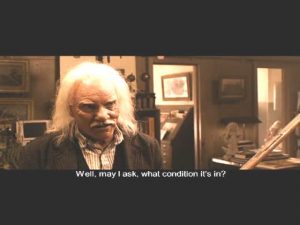
Part of the experience of a book fair, and not one overly discussed for a reason, are the partnerships and the collaborative aspects of the book trade. You don’t necessarily have to go at this alone. Your comrades have your back (or your spine, [excruciating pun intended] which plays out when scouting or acquiring other material to add to the overall inventory. How many times have you heard, “Oh, X, would love/need this!?” If you are willing and able, then serendipity has its moments, in addition to critical partnerships.
It was excellent for me to work along side Brian Cassidy, veteran bookseller and long-time Lux Mentis booth partner; Michael Laird, newly discovered witchcraft buddy; book goddess, Kara Accettola; the adorable and sharp, Jonathan Kearns; and equally as adorable and bright, Simon Beattie. I would also like to recognize, the entire Pirages team [good lord, ya’ll need a drink], Ed Sanders and Travis Low [horns up], Fuchsia Voremberg [hugs], Tom Congalton, and Ashley Wildes. I think Ashley encompasses the entire fair sentiment in one image:
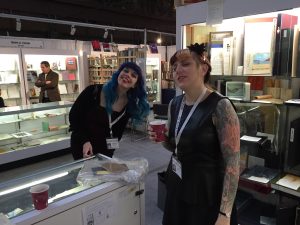
Ashley diffuses the situation with mermaid-like qualities, as Kim wishes Ian to contract mind fleas. [Note: drinks handled with appropriate care]
So, what’s next? Fortunately, we were able to jump over to the “shadow” shows both uptown and across the street to visit both book artists and snap up some “brutally cool” items for down the road to make appearances in iterations of catalog lists forthcoming. What did strike our fancy this year? A selection of things that caught our eye:

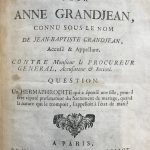



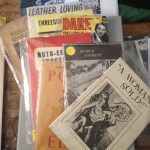


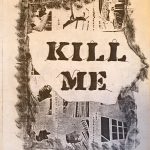
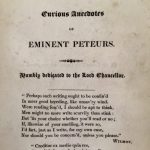

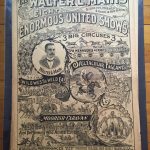
Blog: TWO WRITING TEACHERS (Login to Add to MyJacketFlap)
JacketFlap tags: writing workshop, partnerships, coaching, Add a tag
Do you ever have the feeling that every time you come near a partnership, they stop what they were really doing? Here are ten tips for coaching into partnerships, without taking over.![]()
Blog: ALSC Blog (Login to Add to MyJacketFlap)
JacketFlap tags: Story Walks, programming ideas, partnerships, Dia, Story times, ALSC Liaison with National Organizations Committee, Blogger Liaison with National Organizations, Add a tag
Looking for a project to generate new partnerships? How about a StoryWalk®? These deconstructed picture books, assembled page by page, onto signs along walking paths are ideal outreach activities. StoryWalk®, first developed by Anne Ferguson of Montpelier, Vermont, promote literacy, a healthy lifestyle and so much more. Signage provides space for partner recognition on each page, too.
For a permanent StoryWalk® installation, partnering with local government and parks and recreation departments are a good starting point. Prepare to speak about your project at a council meeting to gain support and funding. If the installation will be at a local park, the parks and recreation office will be key in maintenance of the project. These departments may have a website to help promote the project as well.
StoryWalk® is flexible and mobile, too. Stakes or yard signs can be used to create temporary installations of a StoryWalk® project, suitable for festivals, farmer’s markets and other family events. Harford County Public Library held a StoryWalk® to celebrate a local preschool’s success in reaching their reading challenge. They paraded in storybook costumes from the library to the local park and then enjoyed the StoryWalk® of Old Black Fly by Jim Aylesworth and a picnic lunch. Another of their StoryWalk® projects was held in conjunction with a one-day festival and the local Boy Scouts Pack performed repairs on the stakes, installed the signs along the park greenspace and directed families to the activity.
Additionals partnership opportunities may result by using picture book selection to draw awareness to an organizations’ mission. Celebrate Día this April by installing a StoryWalk® featuring a diverse title from their Building STEAM with Día booklists. Think about the displays your library makes and if a StoryWalk® would add to the collaborative efforts the library has with that organization or cause.
Harford County Public Library is also working with some local museums to plan temporary StoryWalk® projects for the upcoming year. The Susquehanna Museum at the Lock House has an annual Pirate Festival in July and the Havre de Grace Maritime Museum has a beautiful walking path along their wetland area. Both museums offer great spaces for StoryWalks® that support their mission as well as that of the library. Another example comes from West Virginia. The Potomac Valley Audubon Society, which manages three nature preserves, was granted funding to create numerous StoryWalks®. They allow organizations to borrow these StoryWalks® and direct visitors to the public libraries in the area for more information about the featured titles. For a list of their titles visit their website, http://potomacstorywalk.weebly.com/.
StoryWalks® showcase books featuring an irresistible combination of engaging stories, colorful illustrations, and physical activities to promote reading to children. Harford County Public Library follows the example of many other libraries and includes literacy tips for families, focusing on the five practices of singing, talking, reading, writing, and playing every day from Every Child Ready to Read. For more information on The StoryWalk® Project, read Take a Hike! Building Literacy Skills Through StoryWalk® from Boston Public Library, along with information from Lets Go!
Jackie Cassidy is the Havre de Grace Branch children’s librarian for Harford County Public Library, Maryland and is serving on the Liaison to National Organizations Committee for ALSC. Follow the progress of the new Havre de Grace Branch Library Building to be opening this Spring 2016 at www.facebook.com/HdGLibrary.
The post Partnering Through StoryWalks® appeared first on ALSC Blog.
Blog: ALSC Blog (Login to Add to MyJacketFlap)
JacketFlap tags: Professional Development, Collaboration, Summer Reading, training, Partnerships, Blogger Meg Smith, Add a tag

(Image provided by Thinkstockphotos.com)
A children’s librarian’s basket of professional responsibilities often overflows with programming demands and story time schedules. Initially, it may appear impossible to carve out time for training amidst preparing for the next presentation or serving the latest day care, but it’s valuable that we recognize how critical regular training is to our effectiveness in reaching our communities. What training do you hope to add to your basket of professional development? Summer reading workshops, departmental classes, and powerful partnerships will aid us in meeting staff needs.
Sweet Summer Reading

(Image provided by Thinkstockphotos.com)
Fairly soon, a youth services librarian’s busiest time of year will be upon us: the season of summer reading. To encourage and equip staff to meet these demands, the State Library of North Carolina offers summer reading workshops. These one day events provide a variety of sessions for staff serving tots through teens. Some course offerings focus on program logistics, such as how to develop a baby summer reading program, and other sessions highlight a specific type of programming related to the summer reading theme. A popular workshop component includes the summer reading showcase and features professional performers who share their shows with librarians interested in booking these performances for their libraries. These summer reading workshops serve as a valuable training staple for youth services staff within all sizes of public libraries across our state.
Internal Offerings

(Image provided by Thinkstockphotos.com)
Internal training is another valuable resource to place in our professional basket. Whether training is seamlessly introduced through one-on-one instruction or small classes, system-driven training remains critical when determining the effectiveness of staff’s interaction with the public. In addition to two mornings of professional development and classes offered throughout the year, our library gears biannual training specifically toward the needs of youth services staff. Staff suggestions during our Youth Services Advisory Council meetings give youth services managers the forum to provide recommendations of future training topics to strengthen their skill sets. Our spring youth services training will focus on coding programs to enhance staff comfort so we may increase these program offerings for children and teens at our various library branches.
Powerful Partnerships
Youth services partnerships, whether they are with local agencies or other library departments, frequently identity training needs. Conversations with other professionals serving children and teens offer chances to brainstorm, collaborate and to recognize areas of concern within our communities. One example of this partnership is the library’s involvement with the Child Advocacy Center. The Child Advocacy Center provides Darkness to Light training for library staffers who provide youth reference services to assist our employees in recognizing the signs of childhood sexual abuse and to minimize the opportunities for trauma.
Training experiences, found through summer reading workshops, departmental classes, and valuable community partnerships, provide a plethora of rich resources to aid in staff development. How does training strengthen the skills of staff in your communities? What type of training do you want to place in your professional development basket? Please share in the comments below!
The post A Tisket, a Tasket, Put Training in Your Basket appeared first on ALSC Blog.
Blog: The Open Book (Login to Add to MyJacketFlap)
JacketFlap tags: Educator Resources, open ebooks, Book News, ebooks, partnerships, Add a tag
At Lee & Low Books, we’ve always known that making diverse books is only half the battle. The other half is getting those books into schools, libraries, bookstores, homes, and ultimately into kids’ hands. For low-income families, purchasing just one book can seem like a luxury, and giving kids access to a full library can seem like a distant dream. Yet we know that lack of access to books contributes significantly to lower reading levels and a widening achievement gap, leaving many kids in this country behind.
Our motto is “About everyone, for everyone,” and we take that motto seriously, not just in terms of the books we publish but also in terms of access to those books. That’s why we are proud to announce that our books will be part of Open eBooks, a new initiative and e-reader app that will make thousands of popular, top-selling eBooks available free to children in need. Launched this week, the Open eBooks initiative will make it easier than ever for low-income students to get access to great books that build literacy, nourish the soul, and ignite the imagination.
Here’s First Lady Michelle Obama with more information:
We are so excited to be a part of this groundbreaking initiative. Keep reading for the full press release, and please spread the word to anyone you know who may be able to benefit from this program. Registration is now open!
 Open eBooks, a new initiative and e-reader app that will make thousands of popular, top-selling eBooks available to children in need for free, has just launched. First Lady Michelle Obama released a video raising awareness of the new opportunity for children and parents. The initiative is designed to address the challenge of providing digital reading materials to children living in low-income households, and offers unprecedented access to quality digital content, including a catalog of eBooks valued at more than $250 million.
Open eBooks, a new initiative and e-reader app that will make thousands of popular, top-selling eBooks available to children in need for free, has just launched. First Lady Michelle Obama released a video raising awareness of the new opportunity for children and parents. The initiative is designed to address the challenge of providing digital reading materials to children living in low-income households, and offers unprecedented access to quality digital content, including a catalog of eBooks valued at more than $250 million.
President Obama announced a nongovernmental eBooks effort in support of the ConnectED Initiative at the April 30 Kids Town Hall held by the White House at the Anacostia Branch of the District of Columbia Public Library. ConnectED is multi-pronged effort designed to provide all youth with access to high-quality digital learning tools. Since it launched, over 20 million more students have been connected to high-speed broadband in their schools and libraries and millions more are taking advantage of its free private sector resources. Open eBooks complements the new digital infrastructure to provide an opportunity for kids in need to have a world-class eLibrary in their homes.
A coalition of literacy, library, publishing and technology partners joined together to make the Open eBooks program possible. The initiative’s partners — Digital Public Library of America (DPLA), First Book, and The New York Public Library (NYPL), with content support from digital books distributor Baker & Taylor — created the app, curated the eBook collection, and developed a system for distribution and use.
They received financial support from the Institute of Museum and Library Services (IMLS) and content contributions from major publishers. National Geographic announced today that they will provide all of their age-appropriate content to the app, joining publishers Bloomsbury, Candlewick, Cricket Media, Hachette, HarperCollins, Lee & Low, Macmillan, Penguin Random House, and Simon & Schuster, who made commitments providing thousands of popular and award-winning titles last year.
The books in the Open eBooks collection were selected by the DPLA Curation Corps, which was established to ensure a diverse, compelling, and appropriately targeted set of thousands of titles— something from which every child could read, enjoy, and learn. The Curation Corps was selected through a competitive process from a pool of more than 140 applicants from across the country, and they bring their extensive experience helping children select titles in school and public libraries.
Adults who work with children in need through libraries, schools, shelters and clinics, out-of-school programs, military family services, early childhood programs and other capacities can qualify for Open eBooks credentials by first signing up with First Book and then requesting Open eBooks access for the children they serve. Students can download the free Open eBooks app to their individual devices from the App Store or Google Play and enter their access code to start enjoying Open eBooks.
“We are thrilled to be a part of this fantastic initiative that will bridge a major gap in our society and help all children discover a love of reading,” said Dan Cohen, DPLA’s executive director. “Maximizing access to our culture has been the Digital Public Library of America’s goal from its inception, and we are so delighted to join together with such great partners to make eBooks much more widely available.”
“The Open eBooks initiative recognizes the critical need for books — in all forms — among children growing up in families in need,” said Kyle Zimmer, president and CEO of First Book. “We’re proud to support this ground-breaking effort to put high quality digital content into the hands of those who need it most, and to welcome the teachers and program leaders seeking access to these resources into the largest national network of educators serving kids in need.”
“The New York Public Library is proud to work with these partners on the Open eBooks initiative, in support of the White House’s ConnectED initiative that is perfectly aligned with NYPL’s mission to provide free and open access to information, education, and opportunity,” said Tony Marx, president and CEO of The New York Public Library.
“This program is the result of an extraordinary public-private partnership, which could not have been made possible without the support of many committed partners, particularly those in our libraries who really stepped forward to help move this vision into reality,” said IMLS Director Kathryn K. Matthew.
“Digital books open new doors to learning opportunities for students and can underpin brighter educational futures. IMLS is very proud to be a part of this unique initiative.”
“We hope that by donating our technology to this innovative program, we help expand access to information and create new reading opportunities for school-age children throughout America,” said George Coe, president and CEO of Baker & Taylor.
In the future, the partners will expand the initiative by adding to the collection with new and enhanced content from publishers and public domain titles; broadening the network of Title I schools, preschools, libraries, and other programs; incorporating new features into the app; and researching and sharing the effort’s impact and best practices.
Access and Equality
The Open eBooks initiative is a significant step toward more equitable digital access for all U.S. residents, addressing the need for free, quality digital content for children in pre-kindergarten through high school. Specifically targeting youth in need, Open eBooks aims to ensure that any device can be enjoyed as a tool to deepen a child’s love of reading.
While Internet access and device availability remain major hurdles in closing the digital divide, a recent study funded by the Gates Foundation and published by the Joan Ganz Cooney Center finds 85% of families below the poverty line have a mobile device (tablet or smartphone) in surveyed households with children aged 6 to 13. Additionally, a growing number of students can access and borrow electronic reading devices, and connect to the Internet at school and local public libraries. Open eBooks is designed to complement the Wi-Fi, computer, and physical book offerings of public libraries and school libraries, and serve as a gateway to more reading.
The Open eBooks Collection
The catalog of content in the Open eBooks initiative includes contributions of the most exciting, top-selling titles from publishers. Using Open eBooks, children will be able to build their own virtual collection of favorites and access single titles. The major publishers have committed to make thousands of popular and award-winning titles available to students over a three-year period include: Bloomsbury, Candlewick, Cricket Media, Hachette, HarperCollins, Lee & Low, Macmillan, National Geographic, Penguin Random House, Simon & Schuster.
Snapshot of the Open eBooks initiative
Each partner has made, and will continue to make, a unique contribution to the success of this initiative:
● The app: The New York Public Library developed the app that allows users to easily access the full text and illustrations of thousands of titles generously contributed by publishers.
● The distribution services: Baker & Taylor provided support with publisher relations, content management and the digital distribution technology.
● The eBook collection: The Digital Public Library of America recruited and enlisted a team of expert librarians to curate the collection to ensure a diverse, compelling, and appropriately targeted set of thousands of titles—something for every child at any age and reading level to read, learn from, and enjoy.
● Reaching the children: First Book, a non-profit social enterprise that provides books and educational resources to classrooms and programs serving kids in need, will tap into its network of more than 225,000 schools and programs to reach children in Title I schools, Head Start programs, military families, after school or community programs, and others serving low-income families.
Qualifications
The Open eBooks app is available through Title I and Title I-eligible schools as well as libraries, preschools, and community after school programs serving a minimum of 70 percent children in need. The program will also be available through schools and programs serving children whose families are enlisted in the armed forces, or serving special needs children.
How do programs and classrooms get started?
The Open eBooks initiative site, at www.openebooks.net, has full program instructions, including Frequently Asked Questions and links to program registration. From there, qualifying educators, librarians, community program directors, and others working with low-income children and youth must register their organization with First Book. Next, users will request a code and PIN combination for every student they serve or device available, and they should indicate the student’s grade level from one of three categories: elementary, middle or high school. Qualifying educators will be able to obtain enough codes to cover all of the students that they serve. Codes will correspond to Open eBooks Elementary Collection (for PreK – Grade 4), Open eBooks Middle School Collection (for Grades 5 – 8), Open eBooks High School Collection (for Grades 9 – 12). An All Ages code will also be available.
The registrant will receive a confirmation email with the codes and a letter for families and caregivers with instructions on how to download the Open eBooks app and input the code and PIN combination for their child. The app requires a device with an iOS 8.0 or later operating system or Android equivalent.
The Open eBooks app allows users to instantly borrow up to 10 eBooks at a time to their digital device. Each borrowed eBook will be available for 56 days before it must be renewed, or the eBook will be automatically returned. Because of this automatic return process, there are no late fees or penalties for Open eBooks users. Students and their families can choose eBooks based on the topics that get them excited about reading and learning, and sort by reading level, grade level, or title. The app can be used anywhere with an Internet connection.
The First Book Help Team can be reached at [email protected] or by phone at (866) 732-3669 (8am -6pm EST).
Information and updates on the initiative will be shared on the Open eBooks website and on Facebook and Twitter.
Blog: ALSC Blog (Login to Add to MyJacketFlap)
JacketFlap tags: picture books, Professional Development, teachers, Collaboration, Children's Literature (all forms), Evaluation of Media, Partnerships, Blogger Angela Reynolds, Add a tag
Over the past few months, I’ve been part of a Professional Development day for teachers throughout our local school board. They spend the day working on using picture books for reading and writing lessons, and then I come in for an hour and show them how to look at picture books as art objects. My experience on the Caldecott committee really comes in useful here– I have been sharing the books from our 2015 list, because I know those so well. I’ve been able to find something new in the books, to find a different way of looking at the books.
That’s what surprises me most– to find a new way to look at picture books. I have spent so many years as a librarian looking at the art and storytime potential. Now I also look at the teaching potential. For instance: I just learned about “thought tracking”. Basically, it is taking one character and teasing out that character’s thoughts. It is a way to get kids to think about the author’s intent, a way to get them to think about their own writing. In this case, we discover that the dog in Sam & Dave Dig a Hole is a perfect candidate — the dog is never mentioned, nor does it have any dialogue, and yet is is a major character. When I looked at the art, I realized this immediately. But I did not think of it as a writing exercise. So the teachers are teaching me while I am teaching them.
Sharing picture books with teachers has been, then, a learning experience for me. It is a win-win, because not only do I get to share new picture books and how to look closely at them, I get to share library resources. I have started to include a “for teachers” segment in my blog posts. My handouts incorporate all our library social media & website address. I give them library card applications. I remind them that the library is there for them with thousands of classroom materials. This has been the start of a great partnership, one that we both get something from. How do you share books with your local teachers?
The post Taking picture books to teachers appeared first on ALSC Blog.
Blog: ALSC Blog (Login to Add to MyJacketFlap)
JacketFlap tags: Blogger Liaison with National Organizations, Committees, Collaboration, Partnerships, Add a tag
Entering into a new partnership is something not to be taken lightly. In order to make sure you are armed to start out on the right foot, here are some helpful tips to make sure you bring your “A” game.
Do Your Homework-be prepared, know what you bring to the table, be able to answer tough questions, be able to ask tough questions
What are the objectives? Goals?
Why will this partnership help achieve the goal?
How will this partnership add value to your community?
How will this project be funded? If it is grant based, do you have a plan for continuing the program beyond the grant money?
What is your budget? What are your financial expectations from your partner?
Know your barriers.
What is the time commitment?
Include all parties-don’t leave anyone out of the mix.
End outcome-be able to relay the message of what is the desired end outcome. Will this partnership be temporary-project based, or will it continue as new projects come to light?
These are just some tips to get you started. We would love to hear some more from you, please comment below.
Holly Camino is a member of the Liaison with National Organizations Serving Youth Committee and the branch manager at the Middleburg Heights Library in Cuyahoga County (OH).
The post Quick Tips for Creating Partnership Success appeared first on ALSC Blog.
Blog: ALSC Blog (Login to Add to MyJacketFlap)
JacketFlap tags: Programming Ideas, Outreach, Partnerships, Blogger Heather Acerro, Add a tag
 In 2013, Rochester Public Library (MN) met with local organizations and community groups to figure out a way to work together to increase literacy rates. From these meetings a unique and sustainable program, called Rochester Reading Champions (RRC), was created.
In 2013, Rochester Public Library (MN) met with local organizations and community groups to figure out a way to work together to increase literacy rates. From these meetings a unique and sustainable program, called Rochester Reading Champions (RRC), was created.
This tutoring program reduces financial, transportation, and other barriers by training volunteers to offer free and targeted one-on-one Orton Gillingham tutoring to underserved individuals who are struggling to read. Orton Gillingham is a proven tutoring method requiring intensive training.
Through a partnership with The Reading Center/Dyslexia Institute of Minnesota, we currently have 13 volunteers actively working with students. Through September 2015, these highly trained volunteers provided 450 free tutoring sessions. To date, 18 youth and adult students have participated in RRC. Interim assessment results from 2015 show that students in RRC, who attended between 10-50 sessions made average gains of 20% in vowel sounds, 17% in consonant comprehension, and 32% in phonogram comprehension. This early RRC progress is very exciting!
Four innovative elements contribute to the success of RRC. First, Rochester Public Library worked with key partners to identify gaps, barriers, and local resources. Partnerships were created with local organizations committing staff time and other in-kind support. Second, RRC relies on volunteers willing to commit to the intensive training and two years of tutoring. By investing in training for 8-10 new volunteers each year, RRC increases the number of tutors to meet the needs of our expanding community. Third, to reduce financial, transportation, and other access barriers for the students, RRC provides unduplicated and free tutoring to underserved struggling readers at the sites they already visit. Fourth, RRC students receive individualized lesson plans, twice per week for 45 minute sessions. With a standard intervention plan of 80-100 tutoring sessions, this intensive strategy produces at least a 20% improvement of skills.
Partners developed RRC to be sustainable within five years. Any community with strong civic involvement can provide a similar system by adapting RRC’s methodology (i.e. volunteer recruitment form, student in-take criteria, parent questionnaire, partnership agreement, assessment process, and evaluation plan). RRC is designed to be scalable and replicable for any community!
The post Rochester Reading Champions: Literacy Tutoring for Every Community appeared first on ALSC Blog.
Blog: ALSC Blog (Login to Add to MyJacketFlap)
JacketFlap tags: Outreach, Partnerships, Blogger Heather Acerro, Add a tag
 In May, I wrote a blog post about Rochester Public Library’s new BookBike program. Now that we are waiting for the snow to fall here in Minnesota, it seems like time to update you on our wonderful BookBike season.
In May, I wrote a blog post about Rochester Public Library’s new BookBike program. Now that we are waiting for the snow to fall here in Minnesota, it seems like time to update you on our wonderful BookBike season.
The BookBike program took a lot of planning, details, money and scheduling magic. It took us 9 months from the moment we had this bike-tastic idea until we started our outreach schedule; we worked through a single spaced to-do list that was five pages long and involved people from every division of the library. It has been worth every bit of effort that we put into it. So many great things happened out there on the road, where we met people who had never been in our building, where we made connections with kids about reading and biking, and where we shared information and provided access to resources and services. It was a wheelie good time. I’ll stop with the the bicycle puns here. I promise.
We had the BookBike  on the road from late April through September. We carried books for check-out, incentives (bike lights, water bottles, sidewalk chalk, bubbles), technology (iPad running Sirsi Mobile Circ, scanner and wifi hotspot), library information (program schedules and brochures), community resource information, and bicycling and safety equipment (spare tubes, first aid kit, sunscreen, etc.). While out at a BookBike stop we signed customers up for library cards, checked out books, talked up library programs and spaces, provided e-book and digital support, and handed out incentives.
on the road from late April through September. We carried books for check-out, incentives (bike lights, water bottles, sidewalk chalk, bubbles), technology (iPad running Sirsi Mobile Circ, scanner and wifi hotspot), library information (program schedules and brochures), community resource information, and bicycling and safety equipment (spare tubes, first aid kit, sunscreen, etc.). While out at a BookBike stop we signed customers up for library cards, checked out books, talked up library programs and spaces, provided e-book and digital support, and handed out incentives.
We purchased a collection of materials just for the BookBike and shadowed it in the library catalog. We wanted customers to have access to some of the newest and most-popular  items when they visited the BookBike. We created our own spine stickers in house to make sure they didn’t get confused with other items in the collection and could make their way back quickly to the BookBike collection storage.
items when they visited the BookBike. We created our own spine stickers in house to make sure they didn’t get confused with other items in the collection and could make their way back quickly to the BookBike collection storage.
Our outreach schedule was pretty hectic, we had the BookBike out (weather permitting) from five to seven days a week over the summer months. We kept the BookBike within a one-mile radius of the library, which is located in our downtown area. We set up at Honkers baseball games, Rochester Downtown Farmers Market, Rochester Pride Fest, RochesterFest, Art on the Ave and many, many, many local parks.
Seventeen staff volunteered to ride the BookBike and were provided with training on bicycle safety, the Mobile Circ application and general outreach. We also relied on many partnerships to provide us with specialized training, support and opportunities to set-up and meet customers.
 We emailed surveys to everyone who checked out materials during our grant period which ran through June 2015. Of the 59 people who completed the survey:
We emailed surveys to everyone who checked out materials during our grant period which ran through June 2015. Of the 59 people who completed the survey:
- 54% indicated that they learned something new about the library at the BookBike
- 98% rated their experience at the BookBike as good to outstandi
 ng.
ng.
For April through September we attended 113 events, had 5,696 visitors, answered 1,172 questions, checked out 697 items and created 60 new library cards.
We are already making plans for next year for marketing, outreach, collection development and staffing. We learned a lot and will put all that we know to good use as soon as warm spring weather arrives.
The BookBike project was funded in part with money from Minnesota’s Arts and Cultural Heritage Fund, through a Community Collaboration grant from Southeast Libraries Cooperating (SELCO).
The post RPL BookBike: A Wheelie Good Season appeared first on ALSC Blog.
Blog: YALSA - Young Adult Library Services Association (Login to Add to MyJacketFlap)
JacketFlap tags: Pop Culture, YALSA Info., Outreach, Partnerships, Youth Participation, Programming, Teen Services, Add a tag
Last month, I started an anime club at my branch library because anime is still, and always be, popular. In fact, we had six teens show up to the very first meeting and, needless to say, they are super excited to be a part of this program. During our first meeting, I asked the teens what they want to see in anime club and the first thing they asked me was: “Can we do more than just watch anime? I literally screamed “YES!” because I have every intention of diversifying this program and I will definitely need the teens’ help in making this club thrive.
During our discussion about the club, the teens asked for a variety of programs that would include a cosplay event, a history of manga presentation, a Japanese food program, an anime inspired craft workshop, and other programs that celebrate the Japanese culture. Not only are these ingenious ideas, these will transform an already popular program into something else even more awesome. By taking a different approach to anime club, and asking teens what they want from a program, we, as teen services librarians, are demonstrating what it is to be innovative. According to the Core Professional Values for the Teen Services Profession, innovation “approaches projects and challenges with a creative, innovative mindset. 1” By changing the concept of anime club (aka. sitting around and watching anime), we are adding elements that have the potential to not only bring in more teens, but help us re-evaluate our approach to programming in general. For example, when starting a new service or program, it is absolutely essential to consult our teens; by going straight to the source, we establish the outcomes we want to reach, which will shape how we plan and implement a successful program. Once we get a consensus of what teens want from programs and services, we need to figure out the best ways to get teens into the library, which is why we need to get innovative with our outreach.
Although many of us use social media and other marketing methods, the one method that we can always rely on is reaching out to our community. Whether it’s a concert venue, a teen center, a school event, or even a college fair, we need to meet teens face-to-face and tell them what services are available. If we don’t have the means, or the opportunities to go out into the community, we can easily apply that idea to every teen that walks into our library. In other words, we need to be vigilant in making sure that every teen is welcome and that we are available to serve them to the best of our ability. Furthermore, we need to do everything in our power to establish some sort of contact with them, which can easily start with “Hi! I am the Teen Services Librarian. What’s your name?” By initiating, and creating an ongoing dialogue with teens, they will realize that there are actual adults who are dedicated to serving them, which is not only great for us, but incredibly beneficial for those who need a safe environment to be who they are and for those who feel the need to be a part of something. With this new anime club, my hope is to not only involve the teens in the planning process, but give them the chance to be involved in the implementation. Whether it’s passing out flyers, using their massive social network to promote the program, or setting up the program, teens will experience all the necessary steps to finish what they started. Anything is possible with teens so let’s give them the chance to show the community their passion and dedication to providing something unique and fun!
Along with consulting teens, their involvement is essential. By working with our teens, we are not just encouraging youth participation, which is defined in The Future of Library Services For and with Teens: A Call to Action report, we are getting the feedback we need to get in touch with our teen community to ensure that we are supporting their interests and needs 2. By hosting a variety of events that celebrate anime, manga, and Japanese culture, teens will not only be able to interact with their fellow anime and manga enthusiasts, their excitement will lead to other programs and services. In other words, the teens who built the anime club will want the library to provide other programs that relate to their interests, so why not create an art program? What about a Sushi making class? How about an animation workshop? Another great aspect about transforming the traditional anime club is that teens will learn how to communicate, and work, with teen services staff and one another.
With every program we plan, it is imperative we implement a component that prepares teens for adulthood. In this case, teens will learn the importance of working as a group, the need to respect each other’s ideas, the need for positive relationships, and the benefits of being organized and thorough. Moreover, teens will have the opportunity to interact with us, which is not only rewarding, but necessary for teens as they develop. According to The Future of Library Services For and with Teens: A Call to Action report, teen services librarians are being asked to build relationships with teens to support academic, career, and civic engagement and growth2. By developing programs with teens, it is imperative that we help our teens develop the skills they will need as adults, which is why programming can be a great teaching moment. More importantly, we need to help our teens build the confidence to follow through with their goals, which is why it’s important that we work alongside them instead of telling them what to do. By giving teens the opportunity, and the tools, to change our services, we are not only telling them that they matter, but their interests and well-being matter as well.
With all of the ideas that the anime club members came up with, I am very excited to see how our anime club will develop. More importantly, I am more excited about getting to know these teens, which will help me help them become civic minded adults who are confident and willing to take on the challenges of this world and are ready to do what they have to do to become successful.
References:
- http://www.ala.org/yalsa/sites/ala.org.yalsa/files/content/YALSA_CoreProfessionalValues.pdf
- http://www.ala.org/yaforum/sites/ala.org.yaforum/files/content/YALSA_nationalforum_Final_web_0.pdf
Blog: YALSA - Young Adult Library Services Association (Login to Add to MyJacketFlap)
JacketFlap tags: YALSA Info., Outreach, Partnerships, Youth Participation, Add a tag
 As a new member of the YALS Editorial Advisory Board I’m excited about the direction of the journal and how it supports the future of teens and libraries. I’ve just finished reading the fall issue and I can tell you that there are great, inspiring pieces you won’t want to miss. You’ll see the hashtag #act4teens throughout, and that is the focus of this issue. How can libraries and library staff work with community organizations in new ways to support and promote youth? What I appreciated about each #act4teens feature is that while each is about a fairly large-scale program, they can all be adapted to libraries and communities of different sizes.
As a new member of the YALS Editorial Advisory Board I’m excited about the direction of the journal and how it supports the future of teens and libraries. I’ve just finished reading the fall issue and I can tell you that there are great, inspiring pieces you won’t want to miss. You’ll see the hashtag #act4teens throughout, and that is the focus of this issue. How can libraries and library staff work with community organizations in new ways to support and promote youth? What I appreciated about each #act4teens feature is that while each is about a fairly large-scale program, they can all be adapted to libraries and communities of different sizes.
As a public radio fan I was really interested in the piece about Radio Active, an amazing program out of Seattle’s NPR radio station which teaches teens how to create radio stories. The article clearly outlines how you can implement similar workshops and programs in your own library. It’s a modern take on connecting people to stories and each other.
The article about Sociedad Latina is a great example of reaching out to cultural communities. It is co-written by a teen involved in the organization, yet another example of how the group promotes teen voices. The third community organization highlighted is LA Commons, a public art project, which also reaches out to cultural communities. Youth are engaged in seeking out stories from the community and conducting interviews. And speaking of cultural connections, be sure to read the update from the Cultural Competence Task Force. This new YALSA taskforce has been hard at work for the past year and the results are outlined here, including links to resources.
Have you ever wanted to be a published author? Or had a great library experience you wanted to share with others? 50 Tips for Writing and Publishing with YALSA has everything you need to know to make that happen.
And, finally, don’t skip YALSA President Candice Mack’s message about shaking up the status quo in libraries. Her message is both motivational and practical. There are new ways to reach out to our communities and connect with youth. You can make that happen and the fall issue of YALS is there to get you started.
Blog: ALSC Blog (Login to Add to MyJacketFlap)
JacketFlap tags: Programming Ideas, Outreach, Autism, Partnerships, Blogger Angela Reynolds, Special Needs Awareness, Add a tag
A few months back I saw a photo from Hennepin County Library on Instagram. It showed how much fun they had at their Sensitive Family Time — a time for families living with autism to explore the library. As I was looking for a way to partner with our local Autism Centre, I jumped on this fantastic idea. After a few phone calls and emails, we had a date. We opened one of our branches for 2 hours on a Sunday afternoon, just for these families. The families had signed up in advance with the Autism Centre, so we knew who to expect. Staff from their centre attended, and welcomed the families. Our staff were on had to show them around the library, read some stories, and get them signed up for library cards.
We had some toys out (I had these already from storytime), and just let the kids roam around. They played, I read a few books, they enjoyed themselves. Many of the families had never taken their child to the library before– they feared disruptive behavior and did not want to cause a scene. The kids were great — once they found out that the library was a safe, welcoming place, they had a grand time. And so did I. I tried something outside my comfort zone, something I really knew nothing about other than I knew there were families that wanted to use the library but maybe felt uncomfortable doing so.
We’ve got another one in the works, and I look forward to it. It was such a simple idea, such an easy way to reach out. I have to thank Hennepin County Library for their great program, and for graciously allowing me to borrow their idea and run with it. Try something new. It just might be worth it.
The post Trying something new appeared first on ALSC Blog.
Blog: YALSA - Young Adult Library Services Association (Login to Add to MyJacketFlap)
JacketFlap tags: research, Reports, Outreach, Collaboration, Partnerships, America's Promise Alliance, Prof. Development, Teen Services, communities and public libraries, Add a tag
A recent report from America’s Promise Alliance looks at four communities who strove to expand opportunities for their underserved students. With support from the Ford Foundation, these communities leveraged local resources to expand opportunities in a variety of ways.
America’s Promise Alliance is an organization, founded in 1997 with the support from former Secretary of State Colin Powell and previous presidents: Nancy Reagan (standing in for her husband Ronald Reagan), Gerald Ford, Jimmy Carter, George H.W. Bush, and Bill Clinton. The organization strives to create places and situations for students to succeed.
Their report, Expanded Learning, Expanded Opportunities, highlighted the community efforts and the six critical lessons gained from the project as a whole. The four communities that were the focus included:
- Grand Rapids, Michigan – they created a new network of community collaborations that worked in their school districts to tutor and mentor students.
- Louisville, Kentucky – where they sought to expand capacity and participation in their community. Through this expansion, they hoped to raise awareness about programs and resources available.
- Memphis, Tennessee – where they used innovation from the outside to help their schools on the inside. They called it the “Memphis Model” and had programs such as Peer Power.
- Rochester, New York – schools redesigned the learning day, incorporating community organizations into the normal school day for expanded opportunities for their students.
From these case studies, I think the biggest lesson they learned was about community collaboration and support. Their first critical lesson is that collaboration is key, but it’s a lot of hard work. However, when you leverage the resources you have and work towards a greater goal, there is a better chance of making a sustaining impact.
That’s where libraries can come in. I’ve written a bit on studies about after-school programs during my year blogging for YALSA. I kept asking questions to libraries in the field about how their libraries could play a role in after-school programming. However, after reading this report, I want to flip that question: how does the library become a key collaborator and partner? How do we engage actively with our community, especially our schools, and find ways to work within a district? How can we help raise and expand capacity within our libraries which will hopefully spread throughout the community? That might mean we need to “turn outward” (the buzzword right now) and do engagement outside the walls of our physical library space.
And YALSA has lots to say on community collaboration. From our Wiki section devoted to partnerships, to simply searching the YALSA blog with the tag of “collaboration” brings up great articles and examples from the past. The idea of collaboration even ties into the national campaign ALA is devoting time and energy to, Libraries Transform. (And even more specifically with ALA’s collaboration with the Harwood Institute, Libraries Transforming Communities).
My experience so-far in graduate school and my work experiences show that engagement works best when you are actively present and willing to listen. It seems in these case studies that community involvement was constant and this will hopefully lead to a sustained effort. What is important is that once connections are made, they still require work to keep those relationships vibrant. Every day we can have the choice to strengthen relationships and that takes time and effort. But as we can see from these case studies, it’s worth it.
America’s Promise Alliance also released a study this October looking at mentorships with high school students. There’s an interesting article from Huffington Post about one of the students who took part in the mentorship and I think this study is a nice compliment to their expanded learning report.
What do others think of these studies and how do you see your library engaging with the community as a whole?
Blog: YALSA - Young Adult Library Services Association (Login to Add to MyJacketFlap)
JacketFlap tags: Conference, Committees, YALSA Info., Partnerships, Governance, Add a tag
Happy Fall!
Here is what I worked on in September:
Accomplishments
- After board discussion, called for board to vote to approve location for the 2016 YA Services Symposium
- The 2016 YA Services Symposium will be held in Pittsburgh, PA
- Filled various strategic committee vacancies
- Led second monthly chat with the YALSA Board, where we discussed YALSA’s Brand and Reputation
- After board discussion, called for board to vote on Rachel McDonald’s board vacancy
- The board vacancy will be left open until next YALSA election in Spring 2016
- Met with colleagues at Wattpad, National Writing Project, Connected Learning Alliance, and DeviantArt to discuss possible design challenge partnership in conjunction with Teen Tech Week 2016's theme: Create It @ Your Library
- Completed bundled registration for ALA Midwinter and ALA Annual 2016
- RSVP'd to attend ALA Information Policy workshop at ALA Midwinter
Works in Progress
- Preparing for YALSA’s YA Services Symposium & Fall Executive Committee meetings
- Preparing for YALSA Strategic Planning at ALA Midwinter
- Seeking out partnerships with ALA ethnic caucuses, ALA GLBT Round Table, ASCLA, and more
Stats & Data
- Friends of YALSA raised $0 in September 2015
- Membership: 5,088 (down -0.8% over this time last year)
Last, but certainly not least -
THANK YOU
- All of our members for all that you do to support teens and teen library services in your communities, every day!
Until next time!
Respectfully submitted,
Blog: ALSC Blog (Login to Add to MyJacketFlap)
JacketFlap tags: Programming Ideas, Outreach, Partnerships, programming, ALSC Liaison with National Organizations, ALSC Liaison with National Organizations Committee, Blogger Liaison with National Organizations, Add a tag
Located in an urban area, my library has a large population of people experiencing homelessness. All of the schools in the area are Title 1 funded schools, which also indicates a high level of need for transitional housing and other services for families. Although we regularly see homeless populations in the library, I wondered why we don’t see more and what we could do to make these potential patrons feel welcome and aware of not only our warm building in winter months but also our wealth of resources and programming for families.
I developed a loose plan to visit the shelters and homes that serve families, provide a storytime, talk about resources and distribute library cards. I honestly thought it would be a cinch to get the shelters on board. But I was setting myself up for difficulties. I had an elevator pitch that largely skipped why this might be a useful service. When it comes to populations that need food and shelter, the library may be pretty low on the priority list. Honing our elevator pitch to include the ‘why’ is especially important when developing new partnerships.
It was very difficult getting a hold of anyone at any of the handful of organizations I contacted.
I didn’t take it to heart and continued to call and leave messages. What I neglected to do in those messages was to also offer myself up for whatever they might need. Maybe they did not have the time or space for a storytime. Maybe parents really wanted information about our drop-in job hunting courses. Maybe they needed something else. Instead of asking them what they need from the library, I unloaded my assumption of what I thought they needed.
After a few months of calls and email exchanges, one temporary housing organization said they did not have enough staff for my program and they were concerned about their populations’ privacy. That was eye opening because I had approached the partnership entirely from my perspective rather than theirs.
Another transitional housing organization said yes and we were able to schedule visits. Although it was wonderful to provide a storytime, I felt I had much more impact after the storytime when I talked casually with parents and children about the different things the library offers while distributing library cards. In the end the partnership has been successful and we will continue to offer this service once a month at multiple homes.
What have you learned from difficult to cement partnerships?
Arwen Ungar is the Early Learning Librarian at the Vancouver Community Library in the beautiful Pacific Northwest. She is passionate about puppies and early literacy, not necessarily in that order. You can reach her at [email protected].
The post Partnering with Homeless Serving Organizations appeared first on ALSC Blog.
Blog: YALSA - Young Adult Library Services Association (Login to Add to MyJacketFlap)
JacketFlap tags: News, Committees, YALSA Info., Partnerships, Prof. Development, Governance, Add a tag
A huge thank you to everyone who volunteered by the Oct. 1 deadline to serve on YALSA selection, award, and strategic committees and task forces! I'm still busy reading through hundreds of committee volunteer forms and hope to have the process finalized by the end of the month.
In the meantime, don't forget that as YALSA members, you're also a member of ALA! And that means that you can apply to be on an ALA or Council committee. Serving on an ALA or Council committee provides members with leadership training, networking opportunities and experience in working on specific association topics. Additionally, your service on ALA committees strengthens YALSA by ensuring that the Division is well-represented throughout the organization.
Express your interest in ALA committee service by filling out a volunteer form. When you click “submit” at the end, your completed form will be sent to ALA President-Elect Julie Todaro for consideration by either the Committee on Appointments (for ALA and Joint Committees) or the Committee on Committees (for Council Committees). The committees will carefully review your completed form and consider your requests and preferences. This form closes on Friday, November 6, 2015, and appointments are made throughout the spring of 2016, with terms starting July 1, 2016. To volunteer, please complete and submit the form electronically (be sure to select ALA in the drop-down menu on the main form to volunteer for both ALA and Council committees).
Potential ALA Committee members should:
- Consider whether they can attend Annual Conferences and Midwinter Meetings while serving on a committee in order to participate in the F2F meetings and activities of the committee. Check with the current chair to see if attendance is required.
- Have an interest in the work of the committee, and relevant experience or skills to contribute to the group.
- Have the time and skills needed to work between conferences via email, conference calls, Google docs, Skype, etc.
Additional information:
- Committee descriptions are found on the ALA website.
- Members may serve on no more than three committees (across ALA, Divisions, etc.) at a time, and may only serve on one Council committee at a time.
- Consider volunteering as an intern! Serving as an intern is a great way to gain valuable ALA experience. The Intern Program is open to any ALA member who has never been appointed to a position on an ALA or Council Committee, nor held an elected office within ALA or any unit of ALA (including Divisions, Round Tables, etc.).
- Please note that the italicized committees below have specific requirements. Please review the text in parentheses before volunteering for these committees.
The ALA Committees are:
- Accreditation
- American Libraries Advisory
- Awards
- Chapter Relations
- Conference
- Constitution and Bylaws
- Election (members responsible for travel costs to ALA Headquarters in Chicago one day per year in late April or early May)
- Human Resource Development and Recruitment Advisory
- Information Technology Policy Advisory
- Literacy
- Literacy and Outreach Services Advisory
- Membership
- Membership Meetings
- Public and Cultural Programs Advisory
- Research and Statistics
- Rural, Native and Tribal Libraries of All Kinds
- Scholarships and Study Grants
- Training, Orientation and Leadership Development
- Website Advisory
The Council Committees are:
- Budget Analysis and Review
- Council Orientation (current or former ALA Councilors are desired)
- Diversity
- Education
- Intellectual Freedom
- International Relations
- Legislation
- Library Advocacy
- Organization
- Policy Monitoring (only ALA Councilors with terms through 2018 are eligible)
- Professional Ethics
- Public Awareness
- Publishing
- Resolutions (must have experience as an ALA Councilor or have served on a Council Committee)
- Status of Women in Librarianship
The ALA Joint Committees are:
- ALA-Children's Book Council (meets twice a year in NYC and members cover their own travel costs)
- ALA Society of American Archivists/American Association of Museums
For technical assistance or for more information on the committee appointments process, contact Kerri Price, staff liaison to the Committee on Appointments and the Committee on Committees.
Blog: YALSA - Young Adult Library Services Association (Login to Add to MyJacketFlap)
JacketFlap tags: Technology, Reports, Partnerships, Programming, Diversity and Equity, Add a tag
In 2000, the world’s leaders joined together to establish the United Nations Millennium Development Goals. They selected 8 issues that impacted the world, and set a deadline of 2015 to address. In 15 years humanity joined together to reach most of the goals.
Now they have set new goals for us to reach by 2030. They may seem huge, but humanity can be amazing! Everyone will need to reach beyond themselves to help reach these goals, but as providers of service to young adults we can help inspire and encourage everyone to think about these issues that impact the whole world.
![]()
To help promote awareness of these issues Global Goals has created resources and lesson plans for educators to use to engage youth in discussions about these issues and inspire them to become active in helping to reach these goals.
At the heart of libraries we already work hard to address several of these issues every day, but like the video said, let us not stop halfway.
For example Good Jobs and Economic Growth is an area I see libraries all over addressing. Some are partnering to offer technology and other workforce training to the public. Others are out in the community helping to support small businesses. Lastly libraries have resources and materials like Test Prep books, Wifi, and computer printing will help support job seekers.
I recently met Elaine Harger, a middle school librarian, who was incorporating the life cycle of technology into her digital literacy lessons with students. She showed images of children mining for the minerals in cellphones, and computer recycling centers in India. This helps teens understand the true cost of throwing away outdated technology and meets the goal of Responsible Consumption.
Libraries are open welcoming places for everyone. We help reduce inequalities by exposing people to new ideas, solutions, and experiences. In some communities the library can be the only place that minorities feel welcomed and accepted. We encourage people to read, watch, and do things just outside of their comfort level, especially teens. At the heart that is why we fight for intellectual freedom and Banned Books Week.
So we know that libraries are already doing great things, but we need to be more deliberate about making the things we do more visible. Even if you focus on one goal, you can help make a difference in the lives of everyone on the planet by being a role model and advocate for global citizenry.
So as you think about your school year, displays, collection development, or the future libraries, try to incorporate the global goals into your libraries’ services or your vocabulary.
Blog: YALSA - Young Adult Library Services Association (Login to Add to MyJacketFlap)
JacketFlap tags: Teen Services, Teen Programming, community partnerships, YALSA Info., Outreach, Partnerships, Programming, Add a tag
In our last Teen Programming post, we outlined the importance of outreach and how to integrate it into your programming arsenal. Since “outreach” can translate to a wide range of ideas and actions, narrowing it down will help you take your next step towards effective methods of community engagement. This is where partnerships come in! This, however, opens a whole new can of worms. How does one establish positive community partnerships? How do you ensure that your goals aren’t lost in translation? How do I secure beneficial opportunities for teens through partnerships?
When I first began working in my position, I was immediately overwhelmed by the need my community has for the library and its community organizations. During my first few months, I had grand plans to “do it all” and open up so many more opportunity and learning experiences for my community’s teens. What actually happened was that I got burned out and became discouraged. I realized very quickly that I was not going to be able to accomplish many of my goals alone. I needed support from others who were positioned in the community to help me achieve what needed to be done.
So let’s break it down. YALSA’s Future of Library Services report states that today’s teens need libraries to connect them to other community agencies, but how do you establish these connections? Network, network, network! This may sound simple, but community leaders need to know who you are. Start by attending committee and board meetings to get a sense of the issues and climate of your community. PTO (Parent Teacher Organization) meetings are another community body that is important to engage with as they are directly connected to the teens that your services will affect. Are there task forces or coalitions that are specifically directed at alleviating a specific need? Don’t be hesitant to insert yourself into the community conversation because you have your library’s resources to back you up. As a library representative in the community, you are an integral voice in the larger network of organizations that are committed to improving the lives of teens. Pinpoint individuals whose resources are in line with your goals and begin a dialogue with them.
When starting this dialogue, how do you make sure that your goals don’t get lost in translation? Communication is so important when you are making efforts to partner with an outside agency. Before any communication begins, make sure that you have your goals and plans clearly defined. What is it that you want to accomplish? What role do you see this partnering organization offering? Additionally, offer your resources and begin a dialogue about how this partnership would benefit both organizations mutually.
How do you make sure that your partnerships bring beneficial opportunities to teens? Last month we discussed ways to discover your community through outreach. During this discovery process, locate areas that your community needs more from your library. Is there a group that’s being under-served? Who can help you bridge that gap? A few months ago, I recognized a gap in the services that we were offering. At the time, we had reached out to just about every group of teens to make sure that our programs and services were reaching our diverse teens’ needs. However, we hadn’t reached out to teen survivors of domestic violence. I made a connection with the director of a local organization that acts as a transitional agency for teens and families who are leaving abusive situations. They offer temporary housing, counseling, and resources to help them take control of their futures and I wanted the library to be a part of this transition. My goal in partnering with this organization was to bring enriching programs to the teens at this facility, as they might not have access to these opportunities during this transitional period of their lives. Upon meeting with the director, my goals were clearly defined and I listened as she described how our organization could benefit these teens. We agreed upon a plan and programs were implemented at their location. We also offered books from our collection that we had discarded. We wanted to give the teens that she serves the opportunity to continue reading since many of them were temporarily not in school. This partnership was a simple way of offering integral library services to a new demographic while still connecting to the larger community.
Ultimately, libraries must work with partners to alleviate their community’s needs. Start small, make connections, and be diligent about following through. YALSA’s Futures Report pinpoints the shift that libraries are experiencing in the 21st century. We have gone from quiet, solitary locations that provided relatively uniform services to spaces, both physical and virtual, that offer a broad range of resources that empower teens and grow their skills, interests, and goals. Partnerships are integral to meeting this standard because they allow us to continue to broaden the services we offer, bridge gaps in your community, and build a better future for teens.
What are your partnership success stories? How do you bridge the gap in your community with partnerships?
Blog: ALSC Blog (Login to Add to MyJacketFlap)
JacketFlap tags: Outreach, Collaboration, Partnerships, Blogger Angela Reynolds, Add a tag
I recently had a meeting with the Elementary Literacy Consultant at our local school board. Our library region covers the same area as the school board, so that is convenient for us (unlike some large library systems that may have more than one school district). I requested a meeting for a couple of reasons– to listen, and to find out how we can get more teachers using our collections. School libraries have small budgets (and library staff in schools is slim). Students still need access to a wide variety of quality books, and we have them! So how do I get them into the classrooms?
After my meeting, I had a few takeaways and some work to do. I am preparing an invitation to all teachers at all schools to get a library card. I am trying to make it easy– sending them a registration form and outlining the services we have. Our library offers an “institutional” card to teachers — they can check out as many items as they need for their classroom, and keep them for 6 weeks (our normal check-out period is 3 weeks) — and they do not pay overdue fines. It is a good deal – but only if they know about it!
I also plan to create more online booklists with teachers in mind. I asked for (and received!) a curriculum outline–a simple guide to the subjects that are being studied, for each grade. As new books come in, I can now target them for lists or for adding to my blog, which I started with our own library staff in mind. The new books cross my path before they hit the shelves, and as I am addicted to picture books, I can’t help taking piles of them home and making notes. Now I have new ways to look at these books, and I’ve added a section “Of Interest to Teachers” in upcoming blog posts.
With a new focus on teaching from children’s books rather than textbooks, I see this as a win-win opportunity. I’m always looking for ways to make our collection more accessible to our community, and now I have a few ideas for reaching out to teachers. What do you do? How do you partner with schools? How do you get the books into the hands of teachers and students? Let’s hear your ideas!
The post Schoolwork appeared first on ALSC Blog.
View Next 25 Posts





